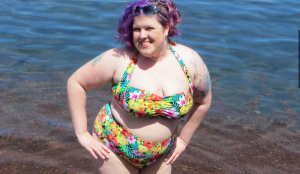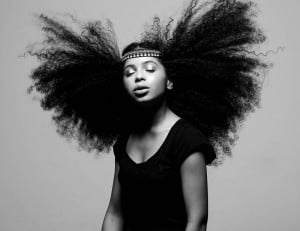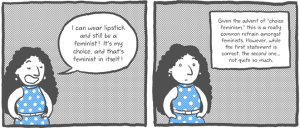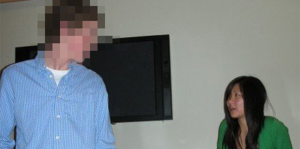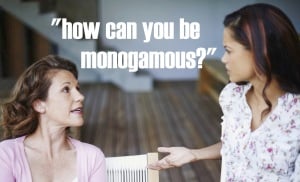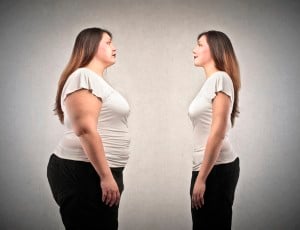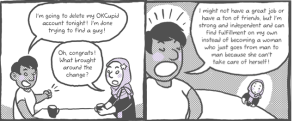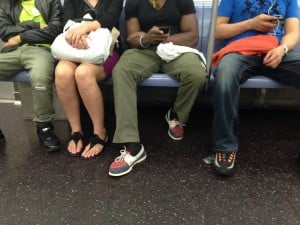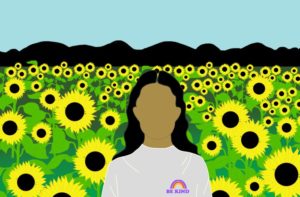
Illustration of a person in a field of sunflowers (By Opashona Ghosh)
This article was originally published on Kajal Magazine and republished here with the author‘s permission.
A few years ago, I truly believed a brown man would save me from my loneliness.
It’s embarrassing to admit now, but at the time, my everyday life was shaped by this hope: if I could just find one to love and desire me, then I’d be rescued from my existential despair, from my perpetual desire to connect with my Indian heritage.
I put all my hope in one man in particular — not only because he was brown, like me, but because he was from a part of India where I’d spent time as a child.
He said my name just right, with an accent and inflection I don’t often hear from others and have never heard from a lover. There seemed to be a possibility in this naming even though, it turned out, there was none.
The year before I met him I was going through a particularly intense period of struggle with my sexuality. I’d been queer my whole adult life and had never dated or been interested in dating straight men. And yet, I suddenly felt myself being pulled toward them.
Was I becoming straight? Was this just a phase? Why brown men in particular?
These questions arose off the heels of a visit to India, where I’d been visiting family and where the allure of heteronormativity was real.
The large size of my family — their endless desire to tell me stories, to take care of me, to bring me into the fold of family despite having spent very little time with me — felt like a balm for the loneliness that often comes with living both a diasporic and a queer life. Indeed, I had been feeling particularly lonely in the months leading up to that trip, isolated as I was in a dead-end academic life and counting the years it had been since I’d really dated anyone.
After being in India for the summer, an apparent solution to this loneliness presented itself; if I could only sift through my queer desires to find the straight ones. And so, dating brown men became my mission.
I pursued them everywhere: on online dating apps, at the gym, at parties, through friends. But the stakes of this pursuit were high, and I accepted harmful things from these men out of hope that they would ease my loneliness.
I persisted with men who did not care about me, who neglected me, who were manipulative and sexually violent — who did not care when I said “no” or, almost worse, did not even think to ask so I could say “yes.”
These encounters only increased my isolation, but it is only in the aftermath of these encounters that I realized this: what I was struggling with that year were not questions of sexuality but questions of love.
Love is, of course, often tied to sexuality. Sexual connections with others remind us that we are worthy of intimacy, that we are capable of loving and being loved in return. But what happens when we see do not see representations of ourselves — brown girls and women — as sexual beings and, thus, as beings who can find the kind of love that sexual intimacy makes possible?
This is a question that many brown women ask along with me, as the recent discussion of brown women’s absence from mainstream film and television has shown. In her essay Why Don’t Brown Women Deserve Love Onscreen?, Nadya Agrawal observes that the increasing popularity of brown men in the media comes at the expense of brown women, who remain largely ignored in representations of love.
Aziz Ansari’s extremely popular Master of None, for instance, remains committed to love stories that feature white women, even if women of color make appearances from time to time.
Ravi Patel’s documentary, Meet the Patels, only shows faceless brown women who are denied sexuality and personhood–whose purpose is to provide an explanation for why Patel’s quest to arrange a marriage for himself inevitably fails.
And, truth be told, I could not even bring myself to watch Kumail Nanjiani’s The Big Sick after watching the trailer where brown women appear only as the asexual foils to Nanjiani’s character’s white love interest.
Taken together, these representations of brown men either ignoring or discarding brown women seem to confirm what the Western media tells brown women more generally: that brown women — adept at making roti, doing math, bearing children, and being obedient — are not really sexual beings, or at least, not sexual beings worthy of lasting and intentional love.
I have never been very committed to representational politics, to arguments that life for people of color will get better if we see ourselves reflected in the world of film and television, business, and even electoral politics.
After all, representation does not result in concrete changes in access to health care, poverty levels, or violence at the hands of police. Rather, representation on these levels often amounts to assimilation.
As much as I enjoyed seeing photos of Priyanka Chopra at the Met Gala, her presence at a $30,000 per-plate fundraiser is not a boon for racial and economic justice. Similarly, the number of South Asians in Silicon Valley merely bolsters capitalism, just as the greater representation of South Asians in the police force only makes us more complicit in state violence against black people.
If what we truly desire is to change the structures that make up our world, then a representational politics will always leave us wanting. But the desire for love is real, too; it exists despite the limitations of representational politics.
This is not a new realization, of course. Queer and trans people, black women, and disabled people, among others, have long said that representation matters precisely because it helps us make sense of and fulfill our desires for love.
But it took me a year of dating straight men to truly understand: we might not have many representations to show us that love is possible for us, but the desire for love remains.
While it is true that brown men symbolized the possibility of a deeper kinship with my Indian roots, I realize now that chasing brown men also became a way of proving that I was loveable — as lovable, in fact, as white women.
I was haunted by the facelessness of Patel’s potential brown wives, by every instance in which I saw myself as a version of the asexual butt of a joke.
I felt angry when I saw brown men with their white girlfriends because it felt like confirmation of what I gleaned from the media: that the feeling of family I craved through loving sexual bonds with other brown people was not possible for me.
When I pursued brown men who did not treat me well, when I accepted levels of neglect and sexual violence from them that I would never have tolerated in my queer life, I was attempting to prove that the love I wanted — but couldn’t see in the versions of the world around me — was possible.
There is loneliness in being written out and, it turns out, there are consequences too.
It took a return to my queer life for me to make sense of that year, of the deep sense of loneliness I felt that was driving my desires. For a while, my queer life found for me a partner — brown but not straight — who guided me with great kindness through a healing process with my sexuality and who helped redeem my visions of family from those limited by heteronormativity.
Yet, in the aftermath of our recent separation, I realize that the cost of never seeing yourself in representations of love is not only that you look for love, as I did, in harmful places; it also inures you to love that is there in healthy and healing places–or that, at the very least, might be there if you simply ask for it.
The seemingly perpetual absence of love makes you anticipate rejection where there might, in fact, be acceptance; it commits you to the small space of your loneliness even when there is the possibility of life outside that loneliness.
Such possibility exists but it requires, as bell hooks says, an unwavering honesty and a “generous heart.” It requires you to sincerely ask for the love you want in the places you might find it–and to ready yourself for the “yes” as well as for the “no.”
***
I long for much more than a greater representation of brown women. I long for a complete overhaul of the racial, gendered, and economic systems that structure our suffering.
But I also long for representation of all people, including brown women, who are in love, who are loveable, and who are — in the absence of love — lonely.
While such representations will not fix greater structural ills, perhaps they will help shift the way we relate to our desires for love and the conditions of our loneliness.
Perhaps they will help us quell the search for love in harmful places and, instead, help us to accept love where and when it arrives. Such acceptance might feel strange for its newness but it is the cost of living fully. We must help each other to do it right.
[do_widget id=’text-101′]
Nisha Eswaran is an academic and writer. You can find her on Twitter @EswaranNisha.
Illustration by Opashona Ghosh.
Search our 3000+ articles!
Read our articles about:
Our online racial justice training
Used by hundreds of universities, non-profits, and businesses.
Click to learn more





